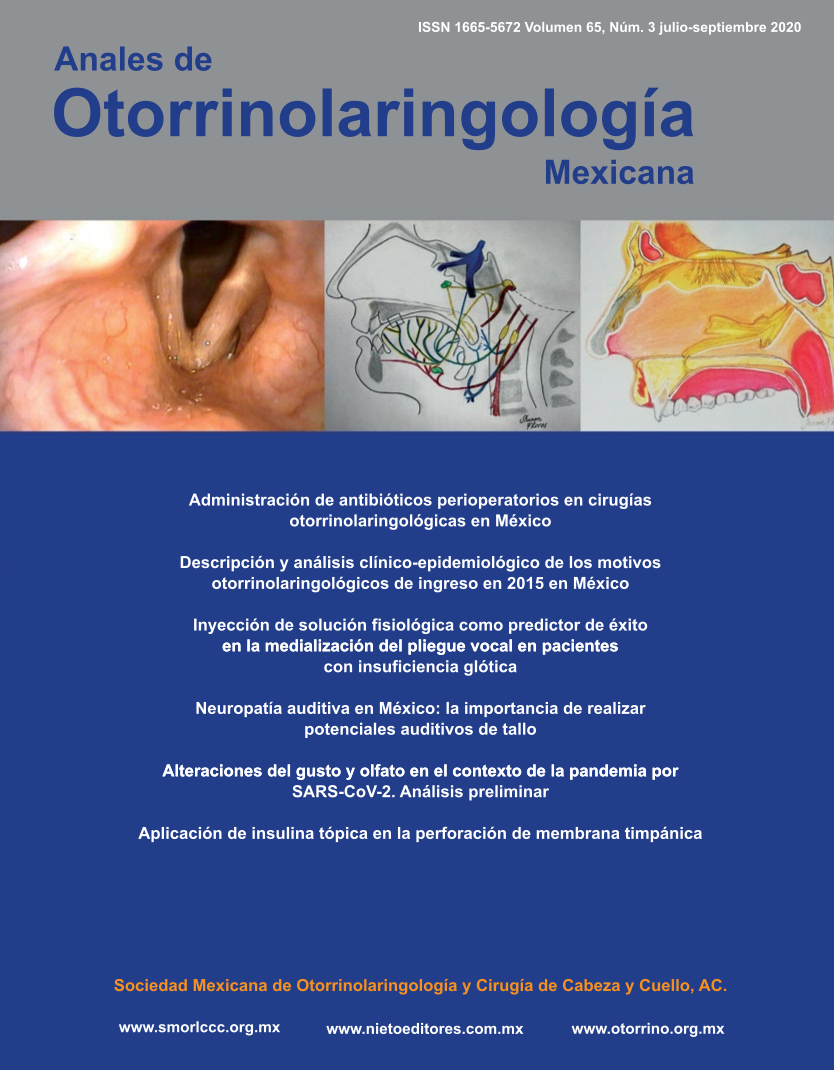
Clinic-epidemiological description and analysis of otorhinolaryngological causes of hospitalization in 2015 in Mexico.
An Orl Mex. 2020; 65 (3): 117-129.
María Isabel Xacur-Hernández, Karen Paola Santos-Zaldívar, Alexis Andrés Quintana-Gamboa, Nina Méndez-Domínguez
Universidad Marista de Mérida, Mérida, Yucatán, México.
Resumen
ANTECEDENTES: La especialidad de Otorrinolaringología genera la mayor proporción de consultas externas y, a pesar de ello, no cuenta con suficientes estudios epidemiológicos.
OBJETIVOS: Describir y analizar la epidemiología de los ingresos hospitalarios por motivo otorrinolaringológico en México en 2015 con insistencia en el efecto del diagnóstico temprano en las demás variables.
MATERIAL Y MÉTODO: Estudio observacional analítico de cohorte transversal retrospectivo de los motivos de egreso con CIE-10 otorrinolaringológico reportados por la Secretaría de Salud en 2015. Con STATA se realizó la estadística descriptiva, pruebas de hipótesis clásicas y estadística analítica con modelos de regresión lineal y multivariada (p < 0.05).
RESULTADOS: Se obtuvo una muestra de 10,153 pacientes, que representó 0.96% del universo. La edad media fue de 19.5 años, 55.5% eran hombres. Los pacientes pediátricos (55.4%) y la vía aérea superior, la faringe y las amígdalas (69.2%) fueron los más afectados. Durante la hospitalización el diagnóstico fue temprano en 90.4% de los casos; la estancia hospitalaria media fue de 2.1 días; la infección intrahospitalaria y defunciones representaron menos de 1% cada una. El diagnóstico temprano se relacionó con menor tiempo de estancia y mayor proporción de altas por mejoría.
CONCLUSIONES: Es poco frecuente que las enfermedades otorrinolaringológicas sean motivo de ingreso hospitalario o de muerte. Un importante factor positivo en la evolución del paciente es el diagnóstico temprano.
PALABRAS CLAVE: Otorrinolaringología; hospitalización; diagnóstico temprano.
Abstract
BACKGROUND: Otorhinolaryngology is the specialty which generates the biggest proportion of external consultation, nevertheless, it doesn’t count with many epidemiological studies.
OBJECTIVES: To describe and to analyze the epidemiology of otorhinolaryngological causes of hospitalization in Mexico during 2015, emphasizing on the impact of early diagnosis on the rest of the variables.
MATERIAL AND METHOD: An observational, analytical and cross-sectional study of hospital discharge causes with an otorhinolaryngological ICD-10 reported by Mexican Health Secretary during 2015. Descriptive statistics, classic hypothesis tests and analytical statistics with linear and multinomial regression models were held by the means of STATA program (p < 0.05).
RESULTS: A sample of 10,153 patients was obtained that represented 0.95% of the universe. The mean age was 19.5 years, 55.5% were men. Pediatric patients (55.4%), upper airway, pharynx and tonsils (69.2%) were the most affected. During hospitalization: an early diagnosis was made in 90.4% of the cases; the mean length of stay was of 2.1 days; in-hospital infection and death occurred both in < 1% of the cases. Early diagnosis was related to a shorter length of stay and a greater proportion of discharges by improvement.
CONCLUSIONS: It is infrequent that otorhinolaryngological diseases are a motive of hospitalization or death. An important positive factor in a patient’s evolution is the early diagnosis.
KEYWORDS: Otorhinolaryngology; Inpatients; Early diagnosis.

